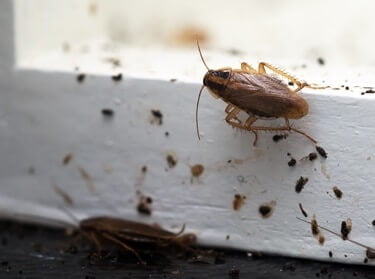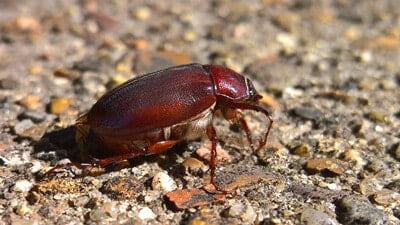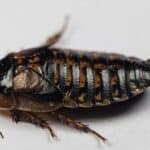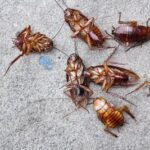Cockroaches seem like simple-minded creatures. They crawl around, eating food with no regard for each other, or so it seems. In reality, cockroaches can communicate with one another in many ways. This won’t be through conversation, though. In fact, you don’t even require one roach to be near another for them to communicate.
Cockroaches communicate through pheromones, allowing them to transmit a variety of intentions, messages, and suggestions. They can warn others that danger is nearby, suggest good food sources, encourage mating, and invite other roaches to a good shelter. For wild roaches, they can communicate through chirping and gentle songs. The Madagaskar hissing cockroach will even hiss to show dominance, attract mates, and ward off attacks.
Roaches don’t hold conversations with each other, but they do share opinions. When foraging, roaches can suggest certain food sources over others. They can also influence the mating habits of their partners. Perhaps most interestingly, roaches use pheromones to tell members of their own colony apart from other colonies.
Can Cockroaches Communicate With Each Other?
Despite appearing disconnected from each other, cockroaches do communicate. In fact, their ability to ‘speak’ may even be considered more complex than our own. They can operate independently while still transmitting long-distance messages between members of their colony.
How Do Roaches Communicate?
Many insects use body language or their antennae to speak. Cockroaches are the outlier. They don’t use either of these methods to signal one another. Instead, wild roaches rely on their ability to create sounds, like chirping or hissing.
Household cockroaches are even more removed from their wild brethren. They don’t make sounds or songs to communicate or indicate that it’s the mating season. Instead, they rely on their sense of smell and the pheromones that they produce.
Stridulation
The first method of communication is found in wild roaches but not household varieties. They will make a sound called stridulation. This refers to when insects create friction with their anatomy, such as rubbing wings or legs together to create a noise.
Roaches also stridulate. By opening and closing holes across their exoskeleton, they create a soft chirp. It’s difficult for humans to detect, but roaches of mating age know it immediately. This sound is intended to attract mates and declare an interest in mating.
Hissing
Only one species of cockroach hisses to communicate. The Madagascar hissing cockroach uses its spiracles to create a very sharp noise. Unlike its other wild brethren, you will clearly hear this sound. It communicates three things:
- Interested in mating
- Get away from my mate
- Get away from me
Males of this species will use hissing to display dominance. Other males will understand by the intensity of the sound if they should really fight with the louder male. Madagascar hissing cockroaches have a hierarchy. By hissing to communicate, they’re able to establish their position.
Females and adolescence roaches can also create this sound, but it’s used in self-defense. They will hiss sharply if:
- Approached by predators
- If touched or handled
- When picked up
It’s speculated that it’s also a warning system, designed to alert other hissing roaches that danger is nearby.
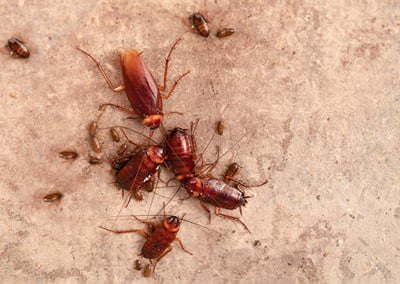
Pheromones
Household roaches do not communicate with each other using noises. Instead, they use a complex range of smells to transmit intent and information. This means they’re not limited by certain distances, line of sight, or an inability to hear. More importantly, the smells not only transmit messages but physically affect the roaches that smell them.
This is accomplished through the use of pheromones, according to The Chemistry of Pheromones and Other Sociochemical. Pheromones function similarly to hormones because they can affect emotions, decision-making, and other behaviors.
However, while hormones impact the organism that created them, pheromones affect the individuals they’re directed towards. This allows a roach to give commands and warnings to one another. When it comes to roaches, there are different types of pheromones. These include:
Sex Pheromones
Sex pheromones are perhaps the most well-studied of their kind. They’re used in mating, and their main purpose is to attract the opposite sex. Who emits these pheromones often depends on the species itself. Indeed, every kind of roach has its own mating behaviors and pheromones to go with them.
How Roaches Emit Sex Pheromones
When ready to mate, your average household roach will emit two different types of chemical signal:
- Sex pheromone. The female of the species often releases this. The pheromone is meant to elicit long-distance attraction to attract a mate.
- Aphrodisiac sex pheromone. This other chemical is emitted by the male, released from the tergal gland. This will encourage female mounting behavior, which is necessary to breed properly.
Cockroaches speak their language of love with a few inhales. They forgo intricate dances or songs in favor of direct commands that facilitate the right behavior.
Aggregation Pheromone
Many pack animals use aggregation pheromones. Despite existing in a nest rather than a pack, cockroaches are no different. This pheromone is used to aggregate roaches or gathers them all into one area. It helps keep the nest well organized and unified as it’s forming and then functioning. With the use of the aggregation pheromone, roaches can tell each other:
- When to move from one location to another
- When and where to forage for food
- Where to find shelter
A roach nest can hold 100+ cockroaches at once. Convincing so many to follow the same pattern would be impossible without this pheromone. Nonetheless, scientists have long since debated what these pheromones are made of:
- Skin. Many believe these pheromones are made from waxy substances found on the surfaces of the roach’s skin.
- Poop. Others believe that these pheromones are found in cockroach poop in the form of nitrogen compounds.
- Fatty Acids. These pheromones are made of fatty acids, but the type is still up for debate.
The Proceedings of the National Academy of Sciences found that every cockroach group has its own aggregate pheromones. It’s just a case of roaches bending their family rules to the needs of their individual species.
How Roaches Emit Aggregate Pheromones
No matter the base material, most roaches emit their aggregate pheromones via bacteria. Across the board, the most popular location of this bacteria is found in poop. These insects will deposit their poop in key locations, which will release aggregation pheromones. By doing so, they can send cues to others of their kind, both far and wide.
However, you’ll only find members of that roach’s colony responding. That’s because every colony has different aggregation pheromones and bacteria. This will be sourced from the food they eat, be it waste, rot, or human food. Roaches that consume the same foods will develop the same bacteria.
This allows nests or colonies to generate a unique scent. Whether that’s intentional or by chance, it does have an advantage. There’s no danger of several nests getting their signals mixed up and inviting different species to a location.
According to the Journal of Insect Physiology, this was discovered by researchers who raised a sterile colony of German cockroaches. They raised the roaches in germ-free cages, meaning their feces were germ-free as well. In normal settings, roaches would be attracted to the feces of the other roaches nearby. However, these germ-free roaches did not aggregate at all. This suggests that the cockroaches lost a valuable way to identify each other and communicate.
To further test their hypothesis, the scientists fed bacteria to the germ-free group of roaches. Only when the roaches had bacteria in their poop did they start forming groups again. Indeed, without the bacteria, the insects didn’t know how to aggregate, with no pheromone to guide them.
Dispersal Pheromone
To increase their chances of survival, roaches also communicate with a dispersal pheromone. This belongs to a larger category known as alarm pheromones. These are used to alert others in the species about potential dangers.
When there’s a clear danger or attack, dispersal pheromones are emitted. With this smell in the air, all nearby roaches know to scatter immediately. It ensures predators can’t easily corner an entire nest or hunt down the larger group. If you kill one, the others will know it’s time to bail. However, the dispersal pheromone is also used in other ways.
How Roaches Emit Dispersal Pheromones
The German cockroach emits dispersal pheromones through their saliva. This isn’t a great way to spread the word about outside danger, but it’s not supposed to. Instead, these roaches use it to add nuance to their warning. There aren’t dangers present in the environment. They’re present within the group.
The nymphs of a colony will use this to scare off larger roaches. As a nest grows, it may become overpopulated, which leads to cannibalism. As the smallest of the group, adolescent roaches are usually the first to be eaten.
In response, they will spread a dispersal pheromone via their saliva over their area. This sends a powerful back-off message to adults in the group. If done correctly, it may deter them from killing off the next generation.
Aside from that, female roaches emit this pheromone when exposed to stressful conditions. The pheromone encourages the males to spread away from the females, giving them space. Otherwise, overcrowding would lead to deadly living conditions.
Interestingly, German roaches do not emit dispersal pheromones for any other reason. They also don’t emit them through different methods, be it from their poop or skin.
Death Stench
Perhaps the most notable way of communicating is through the death stench. According to a study published in Evolutionary Biology, roaches emit a specific pheromone when they die. It’s made up of fatty acids and closely resembles the dispersal pheromone. However, it’s so strong and unique that it can even repel other insects.
The discovery was made when a group of scientists crushed up cockroaches. They were attempting to narrow down the main component of the aggregation pheromone. Instead, they discovered that if they spread the remains of the crushed cockroaches, others would avoid the area. It didn’t just work on roaches. It could repel all insects, including:
- Ants
- Caterpillars
- Woodlice
- Pill bugs
Notably, woodlice and pill bugs aren’t even insects. They are crustaceans, but they produce the same fatty acid as the insects on this list. This led scientists to believe that this ‘death stench’ is an ancient defense mechanism. It would date back to before insects and crustaceans had an evolutionary split. More specifically, that would mean the ‘death stench’ is about 400 million years old.
Throughout the ages, it’s been used by many bugs, including roaches, to send a message: “I died here. You will too. Run away.” The more roaches that die in that area, the stronger the smell will become. This sends a broader message and helps bugs of every kind avoid the kill zone.
Foraging Pheromone
Foraging refers to any behavior in which roaches seek out and gather food. For a long time, scientists believed that roaches foraged individually. Therefore, they would not need to communicate with each other when they did.
However, that’s untrue. According to Behavioral Ecology and Sociobiology, roaches can recommend food sources to other roaches in the group. In the study, roaches were subjected to a test to determine their food preferences. If the roaches didn’t aggregate in one area, this meant that there were no foraging pheromones present. Every roach would be free to pick whatever source of food they wanted instead of going with the group’s choice.
The roaches were presented with two identical food choices. Because they were identical, the lack of pheromones meant the roaches would be evenly distributed. However, it was noted that the majority of roaches fed solely on one source of food. It was only when that source of food ran out that the roaches moved on to the other food source.
This proved that roaches could tell others what food source to seek out first. This helps explain why home infestations are so quick to spread. Once good food is discovered, roaches are quick to spread the word.
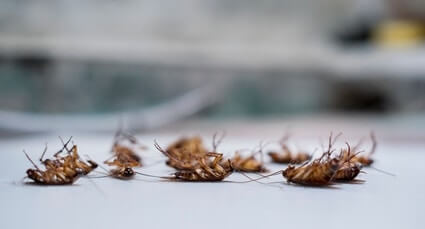
How Roaches Communicate While Foraging
Scientists know that roaches use chemicals to share foraging behaviors. However, it’s uncertain what these chemicals are made from or how they are passed from one roach to the next. There are two theories:
- Contact. The strongest theory is that the roaches share the chemicals through close contact.
- Pheromones. Another plausible theory is that pheromones are used. These could be passed through the roach’s saliva, compounds found on the surface of the roach’s bodies, or poop.
Discovering more about this chemical will help everyday pest control in impressive ways. For example, it could make more effective insecticides or even make insecticide-free traps.
Does Killing A Cockroach Attract More?
The dispersal pheromone is a part of the broader alert pheromones. When things go bad, insects may release this to warn the rest of their nest or colony. The response will either be fleeing or fighting. Bees, for example, will release an aggression pheromone when confronted with danger. This signals others in the group to attack the source of danger.
Despite it being a part of the whole, cockroaches lack this extra pheromone. If you kill a roach, it will release a warning – but not a call to attack. It won’t cause roaches to swarm the body to feed or attack you. Instead, this chemical tells the other cockroaches to run away.
Can Cockroaches Talk To Each Other?
While roaches communicate several kinds of messages to one another, this is all with very basic intent. Their form of talking is always designed to:
- Give a warning
- Issue a threat
- Attract a mate
- Signal that or shelter food is nearby
These signals are very base and provide simple responses. As far as we can tell, roaches don’t have an idle conversation or small talk. They lack the intelligence needed to hold complex conversations or even desire them. You can be sure that roaches communicate, but you might not consider it to be talking.
